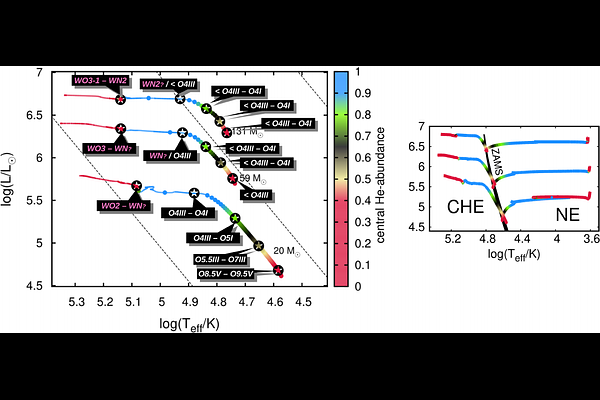Low-metallicity massive single stars with rotation. III. Source of ionization and C-IV emission in I Zw 18

Low-metallicity massive single stars with rotation. III. Source of ionization and C-IV emission in I Zw 18
Dorottya Szécsi, Frank Tramper, Brankica Kubátová, Carolina Kehrig, Jiří Kubát, Jiří Krtička, Andreas A. C. Sander, Miriam Garcia
AbstractChemically-homogeneously evolving stars have been proposed to account for several exotic phenomena, including gravitational-wave emissions and gamma-ray bursts. Here we study whether these stars can explain the metal-poor dwarf galaxy, I Zwicky 18. We apply our synthetic spectral models from Paper II to (i) establish a classification sequence for these hot stars, (ii) predict the photonionizing flux and the strength of emission lines from a IZw18-like stellar population, and (iii) compare our predictions to available observations of this galaxy. Adding two new models computed with PoWR, we report (i) these stars to follow a unique sequence of classes: O->WN->WO (i.e. without ever being WC). From our population synthesis with standard assumptions, we predict that (ii) the source of the UV C-IV and other emission bumps is a couple dozen WO-type Wolf-Rayet stars (not WC as previously assumed) which are the result of chem.-hom. evolution, while these, combined with the rest of the O-star population, account for the He-II ionizing flux and spectral hardness. Contrasting our results against published optical and UV data and accounting for different aperture sizes and spatial regions probed by the observations, we find that (iii) our models are highly consistent with them. Since our "massive Pop II stars" might just as well exist in early star-forming regions, our findings have implications for upcoming JWST surveys; and given that our results apply for binary populations too as long as the same fraction (10%) of the systems evolves chem. homogeneously, we conclude that the stellar progenitors of gravitational waves may very well exist today in IZw18.